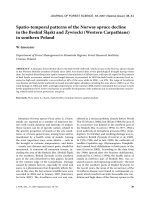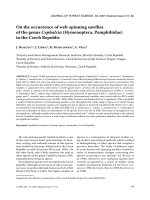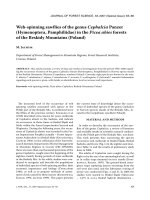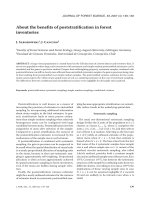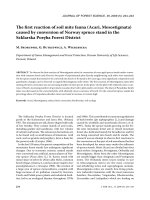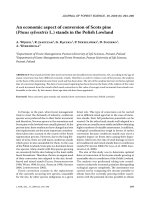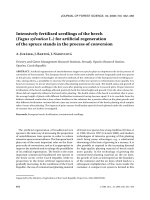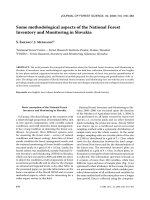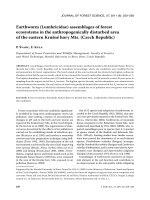Báo cáo lâm nghiệp: "In situ measurement of leaf water use efficiency of lilac (Syringa vulgaris): comparison with crop plants" docx
Bạn đang xem bản rút gọn của tài liệu. Xem và tải ngay bản đầy đủ của tài liệu tại đây (176.79 KB, 5 trang )
In
situ
measurement
of
leaf
water
use
efficiency
of
lilac
(Syringa
vulgaris):
comparison
with
crop
plants
O.
Bethenod,
J.
Pilarski*
P.
Quetin
INRA,
Station
de
Bioclimatologie,
78850
Thiverval-Grignon,
France
Introduction
In
order
to
understand
the
regulation
be-
tween
the
net
COg
assimilation
rate
(A)
and
the
transpiration
rate
(E),
leaf
gas
exchange
was
measured
in
the
field;
leaf
water
use
efficiency
(WUE)
of
lilac
(Syrin-
ga
vulgaris)
was
compared
to
those
of
maize
(Zea
mays
L.)
and
potato
(Sola-
num
tuberosum
L.).
Bierhuizen
and
Slatyer
(1965) pointed
out
that,
for
a
given
water
saturation
deficit
(vpd),
WUE
(AlE),
at
the
leaf
level
depends
upon
the
intercellular
CO
2
concentration
(C
i)
and
stomatal
conduc-
tance
(g
c
):
A= g
c
(C
a
- Ci);
E= 1.6 9c
(vpd);
AlE=
(C
a-
Ci
)/1.6
vdp;
with
Ca
=
C0
2
concentration
in
air.
A
direct
estimate
of
WUE
is
therefore
given
by
the
slope
of
the
relationship
be-
tween
A
and
g,.
All
3
species
considered
here
are
able
to
maintain
their
xylem
water
potential:
regardless
of
the
value
*
Present
address:
Polish
Academy
of
Sciences,
Laboi
their
predawn
water
potential
reached
be-
tween
0.2
and
0.6
MPa,
the
minimal
xylem
water
potential
did
not
fall
below
-1.3
MPa
for
potato
and
-1.6
MPa
for
maize
and
lilac
at
Grignon.
In
this
case,
Ci
remains
constant
throughout
the
day
(Bethenod
et
al.,
1988).
Jones
(1973)
proposed
to
represent
this
regulation
by
the
curve
of A
versus
Ci
called
the
demand
function
(Farquahar
and
Sharkey,
1982).
If
Ca
is
placed
on
the
Ci
axis,
the
leaf
C0
2
conductance
(g
c)
is
the
slope
of
the
straight
line
joining
Ca
to
the
corresponding
Ci
on
the
demand
func-
tion:
this
defines
the
supply
function.
Our
first
aim
was
to
study
the
proportionality
between
A
and
gc,
in
order
to
show
how
demand
function
and
supply
function
adjust
to
each
other.
But
beyond
a
limit
on
the
demand
function,
Ci
increases
and
WUE
decreases
because
of
large
gc
values;
A
then
remains
at
its
maximal
value
(A
max
).
The
second
aim
of
this
work
was
to
compare
the
A
max
values
for
the
studied
species.
ratory
of
Photosynthesis,
St
Jana
22,
31-018
Cracow,
*
Present
address:
Polish
Academy
of
Sciences,
Laboratory
of
Photosynthesis,
St
Jana
22,
31-018
Cracow,
Poland.
Materials
and
Methods
Lilac,
potato
and
maize
were
grown
in
the
field
at
Grignon,
40
km
west
of
Paris.
Measurements
were
made
with
a
Parkinson
leaf
chamber
(A.D.C.).
The
gas
circuit
was
modified:
pressurized
dry
air
from
cylinders
pro-
vided
a
C0
2
concentration
in
the
chamber
higher
than
that
in
natural
air.
Two
gas-flow
controllers
(Tylan)
ensured
a
constant
flow
rate
at
both
reference
and
chamber
levels.
C0
2
net
assimilation
(A)
data
were
normal-
ized
at
338
jlmol
’
mol-
1
for
Ca,
according
to
Bethenod
et
al.
(1988)
for
C3
leaves;
for
C4
leaves,
A
is
approximately
the
same
above
320
jlmol
’
mol-
1
C0
2.
Fig.
1
shows
3
hypothetical
adjustments
between
demand
and
supply
func-
tions.
The
data
shown
in
following
figures
cor-
respond
to
a
typical
day
for
each
species.
Each
symbol
represents
a
leaf
on
different
plants
in
the
field
for
maize
and
potato,
and
of
2
trees
in
a
hedge
for
lilac.
Results
Normalized
net
assimilation
(/!)
is
plotted
versus
photosynthetic
photon
flux
density
(PPFD)
in
Fig.
2.
Note
that
the
lilac
data
show
a
low
scatter.
For
potato,
the
high
scatter
could
indicate
water
stress;
but
this
is
not
apparent
from
leaf
water
potential
data
(Bethenod
et
al.,
1988).
This
scatter
can
be
induced
by:
1)
individual
variability
and
2)
changes
in
A
between
morning
and
evening
at
the
same
level
of
incident
PPFD.
The
maximum
values
for
potato
are
about
the
same
as
those
for
lilac.
Ci
increases
slightly
when
PPFD
de-
creases
below
500
ymol-m-
2
-s-
1
(Fig.
3).
Fig.
4
disp:lays
,4!
versus
g,.
Up
to
g!
values
between
0.20
and
0.23
mol
’
m-
2’
s-
1,
the
gc
dependence
of
Ac
is
almost
linear
and
the
slope
of
this
line
represents
Ca
- C
i.
Beyond
these
values,
A
does
not
increase
for
both
C3
plants,
although
g.
can
be
large
for
lilac.
Conse-
quently,
2
phases
exist
in
this A -
gc
rela-
tionship:
a
Ci
regulated
phase
for
g!
below
0.2
mol
’
m-
2’
s-
1,
and
a
maximum
assimila-
tion
phase
for
gc
above
0.23
mol!m-2!s-!.
Discussion
and
Conclusion
The
relation
between
net
assimilation
(A!)
and
leaf
conductance
to
C0
2
(g!)
is
de-
scribed
by
a
hyperbolic
curve
(Schulze
and
Hall,
1982;
Kuppers.
1984),
which
may
be
reduced
to
both
asymptotes
(Per-
eira
et
al.,
1987).
The
regulated
phase
and
the
maximum
assimilation
phase
could
be
summarized
by
these
2
asymp-
totes
(Fig.
5).
H
is
the
point
where
the
maximum
of
demand
function
crosses
the
C;
regulation
line.
We
can
observe
that,
if
WUE
of
maize
is
higher
than
the
WUE
of
lilac
or
potato,
the
junction
occurs
within
the
same
range
of
values
of
ge
(0.2::=;;g
e
<0.23
mol.m-
2’
s-
1)
for
the
3
plants
studied
here,
which
are
known
to
be
very
different
from
one
another
as
far
as
C0
2
fixation
is
concerned.
Above
these
values
of
gc,
water
is
wasted.
Bethenod
0.,
Katerji
N.,
Quetin
P.
&
Bertolini
J.M.
(1988)
Efficience
de
I’eau
d’une
culture
de
pomme
de
terre
(Solanum
tuberosum
L.
cv.
Bintje)
1.
Mise
en
evidence
de
la
r6gulation
du
C0
2
interne
A I’dchelle
foliaire.
Photosynthetica
22,491-501
Bierhuizen
J.F.
&
Slatyer
R.O.
(1965)
Effect
of
atmospheric
concentration
of
water
vapor
and
C0
2
in
determining
transpiration photosynthe-
sis
relationship
of
cotton
leaves.
Agric.
Meteo-
rol.
2,
259-270
Farquhar
G.D.
&
Sharkey
T.D.
(1982)
Stomatal
conductance
and
photosynthesis.
Annu.
Rev.
Plant
Physiol.
33,
317-345
Jones
H.G.
(1973)
Limiting
factors
in
photosyn-
thesis.
New Phytol.
72, 1089-1094
Kuppers
M.
(1984)
Carbon
relations
and
com-
petition
between
woody
species
in
a
Central
European
hedgerow.
II.
Stomatal
response,
water
use,
and
hydraulic
conductivity
in
the
root/leaf
pathway.
Oecologia
(Berlin)
64,
344-
354
Pereira
J.S.,
Tenhunen
J.D.
&
Lange
O.L.
(1987)
Stomatal
control
of
photosynthesis
of
Eucalyptus
globulus
Labill.
Trees
under
field
conditions
in
Portugal.
J.
Exp.
Bot.
195,
1678-
1688
Schulze
E.D.
&
Hall
A.E.
(1982)
Stomatal
responses,
water
loss
and
C0
2
assimilation
rates
of
plants
in
contrasting
environments.
In:
Physiological
Plant
Ecology
II:
Water
Relations
and
Carbon
Assimilation.
(Lange
et
aL,
eds.)
Encyclopedia
of
Plant
Physiology
New
series,
vol.
12B,
Springer-Verlag,
Berlin,
pp. 181-230
Wong
S.C.,
Cowan
LR.
&
Farqubar
G.D.
(1979)
Stomatal
conductance
correlates
with
photo-
synthetic
capacity.
Nature
282,
424-426
